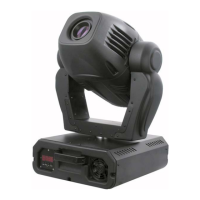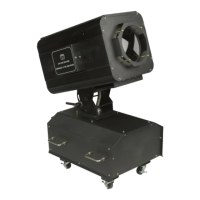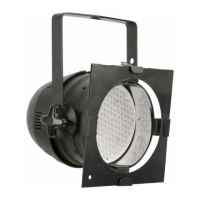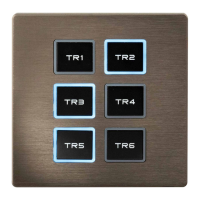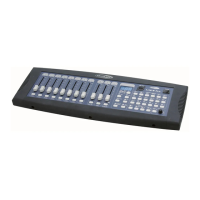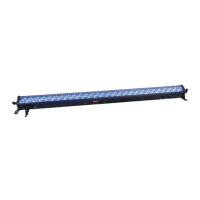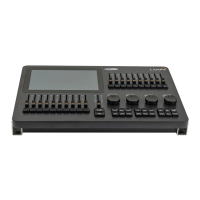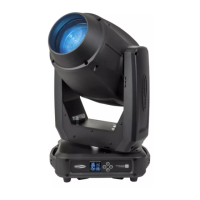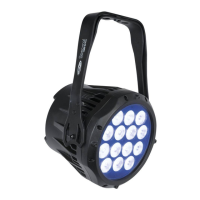
Do you have a question about the SHOWTEC Spectral M800 Q4 Tour and is the answer not in the manual?
| Light Source | LED |
|---|---|
| LED Type | RGBW |
| Control Protocol | DMX512 |
| IP Rating | IP20 |
| Pan Range | 540° |
| Tilt Range | 270° |
| Protocols | DMX512 |
| Display | LCD |
| Power Supply | 100-240V AC, 50/60Hz |
| Wattage | 10W |
Essential instructions to follow before installing, operating, or servicing the product.
Specifies the device is designed for professional indoor use as a spot light.
Advice on extending the device's lifespan by disconnecting power when not in operation.
Explains LED lumen depreciation and methods to extend LED lifespan.
Details formatting conventions used for buttons, references, and notes in the manual.
Defines safety symbols (DANGER, WARNING, CAUTION, Attention, Important) and their meanings.
Describes symbols found on the device's information label for compliance and warnings.
Critical safety warnings including dangers for children and electric shock hazards.
Ensuring correct voltage, current, and frequency match for safe power connection.
Important safety advice for operating the device, including handling and maintenance.
Emphasizes the device is for professional use and highlights risks of incorrect application.
Check for physical defects like loose screws, damaged parts, or cable fatigue before each use.
Advises against exposing the IP20 rated device to conditions exceeding its protection limits.
Defines roles for ordinary, instructed, and skilled persons in device operation and maintenance.
Identification of key components visible on the front of the device.
Identification of connectors and controls located on the back of the device.
Detailed specifications including electrical, physical, optics, control, and thermal properties.
List of optional accessories that can be purchased separately for the device.
Provides the physical dimensions (length, width, height) of the device.
Critical safety warnings for installation, emphasizing skilled personnel and regulations.
Recommendation to wear appropriate PPE during installation and rigging.
Guidelines for installation location, including indoor use and environmental conditions.
Steps for securely rigging the device using clamps and secondary suspension.
Instructions for tilting and securing the device's angle using the adjustment screw.
Procedure for attaching the accessory frame to the device for mounting other accessories.
Steps to install the barndoor accessory onto the device's accessory frame.
Steps to install the tophat accessory onto the device's accessory frame.
Steps to install the filter frame accessory onto the device's accessory frame.
Instructions for installing the optional free-standing bracket onto the device.
Essential steps and safety warnings for connecting the device to AC power.
Guidelines and warnings for connecting multiple devices in series via power linking.
Crucial safety notes regarding data cable connections and power supply during setup.
How to operate the device manually or in auto mode without external control.
Introduction to DMX connection, protocol, and device linking.
Information on DMX-512 protocol, pin assignments, and linking limitations.
Guidance on using 5-pin XLR DMX cables and avoiding audio cables.
Step-by-step guide for setting up multiple devices in a master/slave configuration.
Instructions for connecting multiple devices in a serial daisy-chain via DMX.
Guide to assigning correct DMX starting addresses for multi-device setups.
Safety warnings specific to operating the device, focusing on intended use and power.
Overview of control modes: Stand-alone, Master/Slave, and DMX-512/RDM.
Identification of the LED display, buttons (MENU, ENTER, UP, DOWN) on the control panel.
Description of the device's start-up display and software version identification.
Diagram illustrating the main menu structure and navigation flow within the device.
List and brief explanation of the main menu categories (STAT, AUTO, RUN, DMX, etc.).
How to select static colors, adjust intensity, and set strobe effects.
How to select and activate pre-programmed shows or user-created custom programs.
Steps to configure the device to act as a slave in a master/slave setup.
Procedure for setting the device's DMX starting address.
How to select different DMX channel modes for RGB and RGBW configurations.
Detailed steps for entering Edit Mode to create and modify custom lighting programs.
Guide to creating custom programs by defining scenes and their parameters.
Accessing and navigating various device settings like upload, reset, and color calibration.
Procedure for exporting programs from a master device to connected slave devices.
How to reset all custom programs back to their default factory settings.
Options for adjusting color calibration functions, including RGBW and universal color settings.
Setting the speed at which the dimmer levels change (DIM1-4 and OFF).
Choosing between different dimming curves (linear and non-linear) for light output control.
Configuring the device's response to a lost or interrupted DMX signal.
Enabling or disabling the lock on the settings menu, requiring a password for access.
Selecting between special strobe and classic strobe modes for flashing effects.
Adjusting the PWM frequency to influence dimmer grayscale and reduce flicker.
Accessing calibration procedures for white color and RGB settings.
Adjusting the temperature and intensity of built-in white color presets.
Adjusting the intensity of Red, Green, and Blue channels for precise color calibration.
Instructions to reset all calibration settings to their default values.
Configuring the display lock feature that activates after a period of inactivity.
Viewing the currently installed software version of the device.
Reference for DMX channel functions and values across different personalities.
Details DMX channel mapping for various RGB personalities (e.g., TOUR, AR1.D).
Details DMX channel mapping for various RGBW personalities (e.g., SSP, 8BIT).
Lists supported RDM Parameter IDs (PIDs) and their associated commands.
Safety warnings related to electric shock and hot surfaces during maintenance procedures.
Pre-maintenance checks for device defects, ensuring structural integrity and safety.
Step-by-step guide for cleaning the external lens and device connections.
Information on repairs and servicing, emphasizing professional assistance for internal issues.
Safety warnings and procedures for safely dismounting and removing the device.
Recommendations for transporting the device, including using original packaging.
Guidelines for cleaning and storing the device properly, preferably in original packaging.
Information on proper disposal of the product as electronic waste, avoiding environmental harm.
Information on checking the website for the product's declaration of conformity.
